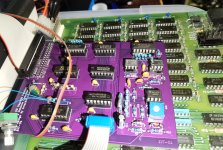I just rechecked, and of the critical change I made to the PCB;
Filter caps were whatever I could find. Mostly 0.1uF... And electros that fit. Also, a 7438N is important. I've heard of these types of projects failing if a LS is used. And all the chips came from Aliexpress.
=R2 in my case needed to be 11.1K, rather than 10K to get the right pulse width - likely because I used a cheap ceramic cap instead of a highly accurate one, so it was out by around 10%
=R3 150r - I just needed a little more power to bring the zener up to voltage for 5.1
=R11 120r - I couldn't find the 180s or 150s when I was looking. But it works, so I left it there, also it's the 9v1 zener for me rather than the 8v7 so the drop is no as much.
=R6 10K instead of 11K - because I couldn't find an 11K at the time.
=R8 15K instead of 16K - because I couldn't find a 16K at the time, and R6 was 10K, so I went with a smaller resistor.
=D3 - 9V1 Zener because I couldnt find a 8V7.
That was it. The rest was out of tolerance, but values were correct.
For me, the process was get the read pulse width correct, then I put the CRO on pin 7 of U9, and found that while adjusting the pot, it would snap to 1MHz at times, so I picked the middle of this "sweet spot" and left the pot there.
Once I did that, a disk loaded up just fine. I still have to replace the pot at R2 with a 1K1 resistor, or thereabouts... I might even go 1K2. The pulse is a little on the short side and the rise time slower than I would prefer.
David








